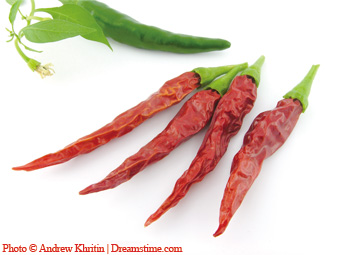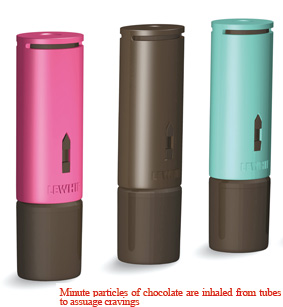Foods you can inhale, an infused energy drink and vitamin-enriched spices are some of the sizzling choices

ATEA that enlivens the senses and an inhaler that provides a caffeine kick are the world's newest consumer goods identified by Product Launch Analytics from Datamonitor, a comprehensive and detailed source of information for newly launched consumer packaged goods from around the world. Cesar Pereira, research manager at Product Launch Analytics (PLA), said the new trends focus on the development of tastes in food and drinks as well as demonstrates how producers are capitalising on both health and convenience. "The coffee inhaler and vitamin-infused seasonings are an examples of growing worldwide trends and give us an insight into what Asia-Pacific consumers may be seeing on the high street," Mr Pereira also said. Breathable Food Talk about "on the go". The latest and most portable way of getting a chocolate or caffeine fix have led the experts at Product Launch Analytics to predict it may be hitting shelves in the Asia-Pacific region. Both the coffee and the chocolate are "consumed" by merely inhaling from a tube - look, Ma, no cup - the first commercial step toward breathable food, according to the brand Le Whif. In a way familiar to asthmatics that use inhalers, consumers breathe the chocolate or coffee powder into their mouths. David Edwards, a professor of biomedical engineering at Harvard University, used particle engineering technology to reduce the particle sizes, so that they are small enough to become airborne but too large to enter the lungs. The inhaler was developed by Professor Edwards' ArtScience Labs network. Cravings can be assuaged with Le Whif breathable chocolate. All four variants, the Raspberry, Dark Chocolate, Mango and Mint, contain less than one calorie. The single-use coffee inhaler provides 100mg of caffeine with one puff, the same amount found in one cup of espresso. The breathable coffee powder is said to deliver its caffeine "without all that drinking and swallowing messiness". The downside for these portable, breathable foods the amount of disposable packaging, although Professor Edwards says the packaging is biodegradable. Not Your Average Cuppa All sorts of tea blends and herbal teas are popping up on market shelves, but two types of tea have been cited by PLA as likely to find a following in the region: an energy-boosting blend and a slimming and anti-aging tea rolled into one.

A new tea range based on the Amazonian herb Ilex guayusa, Runa Loose Guayusa Tea and Runa Guayusa Tea Pyramid Sachets in Tropical Ginger Citrus, Traditional, and Rainforest Mint varieties, has been introduced in the US by Runa LLC, which teamed with communities of indigenous farmers in Ecuador to share the guayusa tradition with the world. Sourced from shaded areas of the Amazon rainforest, guayusa (pronounced "why-you-suh") is said to soothe upset stomachs and also "enliven the senses." Guayusa apparently combines the stimulating effect of caffeine with the medicinal and relaxation benefits of a chemical called guanidine. This unique combination of functional benefits could see the new "super ingredient" gain some traction in the market and the teas as "alternative energy drinks". The organic and Fair Trade labels could also push these teas into the mainstream. Slimming teas and collagen in anti-aging products are certainly mainstreamed, but how about collagen in your slimming tea? Vitalab Laboratorios, a Brazilian-based manufactured, has launched its Vitalab Vitamagris Weight Loss Tea. The sweetened tea powder features a mix of hydrolysed collagen and olive leaf, which can be dissolved in hot or cold water. The recommended daily intake is three to four cups, each with a tablespoon (approximately 10 g) of the tea powder in 200ml of hot or cold. Each tablespoon
Kobe 11 ELite Glowing ATEA that enlivens the senses and an inhaler that provides a caffeine kick are the world's newest consumer goods identified by Product Launch Analytics from Datamonitor, a comprehensive and detailed source of information for newly launched consumer packaged goods from around the world. Cesar Pereira, research manager at Product Launch Analytics (PLA), said the new trends focus on the development of tastes in food and drinks as well as demonstrates how producers are capitalising on both health and convenience. "The coffee inhaler and vitamin-infused seasonings are an examples of growing worldwide trends and give us an insight into what Asia-Pacific consumers may be seeing on the high street," Mr Pereira also said. Breathable Food Talk about "on the go". The latest and most portable way of getting a chocolate or caffeine fix have led the experts at Product Launch Analytics to predict it may be hitting shelves in the Asia-Pacific region. Both the coffee and the chocolate are "consumed" by merely inhaling from a tube - look, Ma, no cup - the first commercial step toward breathable food, according to the brand Le Whif. In a way familiar to asthmatics that use inhalers, consumers breathe the chocolate or coffee powder into their mouths. David Edwards, a professor of biomedical engineering at Harvard University, used particle engineering technology to reduce the particle sizes, so that they are small enough to become airborne but too large to enter the lungs. The inhaler was developed by Professor Edwards' ArtScience Labs network. Cravings can be assuaged with Le Whif breathable chocolate. All four variants, the Raspberry, Dark Chocolate, Mango and Mint, contain less than one calorie. The single-use coffee inhaler provides 100mg of caffeine with one puff, the same amount found in one cup of espresso. The breathable coffee powder is said to deliver its caffeine "without all that drinking and swallowing messiness". The downside for these portable, breathable foods the amount of disposable packaging, although Professor Edwards says the packaging is biodegradable. Not Your Average Cuppa All sorts of tea blends and herbal teas are popping up on market shelves, but two types of tea have been cited by PLA as likely to find a following in the region: an energy-boosting blend and a slimming and anti-aging tea rolled into one.
ATEA that enlivens the senses and an inhaler that provides a caffeine kick are the world's newest consumer goods identified by Product Launch Analytics from Datamonitor, a comprehensive and detailed source of information for newly launched consumer packaged goods from around the world. Cesar Pereira, research manager at Product Launch Analytics (PLA), said the new trends focus on the development of tastes in food and drinks as well as demonstrates how producers are capitalising on both health and convenience. "The coffee inhaler and vitamin-infused seasonings are an examples of growing worldwide trends and give us an insight into what Asia-Pacific consumers may be seeing on the high street," Mr Pereira also said. Breathable Food Talk about "on the go". The latest and most portable way of getting a chocolate or caffeine fix have led the experts at Product Launch Analytics to predict it may be hitting shelves in the Asia-Pacific region. Both the coffee and the chocolate are "consumed" by merely inhaling from a tube - look, Ma, no cup - the first commercial step toward breathable food, according to the brand Le Whif. In a way familiar to asthmatics that use inhalers, consumers breathe the chocolate or coffee powder into their mouths. David Edwards, a professor of biomedical engineering at Harvard University, used particle engineering technology to reduce the particle sizes, so that they are small enough to become airborne but too large to enter the lungs. The inhaler was developed by Professor Edwards' ArtScience Labs network. Cravings can be assuaged with Le Whif breathable chocolate. All four variants, the Raspberry, Dark Chocolate, Mango and Mint, contain less than one calorie. The single-use coffee inhaler provides 100mg of caffeine with one puff, the same amount found in one cup of espresso. The breathable coffee powder is said to deliver its caffeine "without all that drinking and swallowing messiness". The downside for these portable, breathable foods the amount of disposable packaging, although Professor Edwards says the packaging is biodegradable. Not Your Average Cuppa All sorts of tea blends and herbal teas are popping up on market shelves, but two types of tea have been cited by PLA as likely to find a following in the region: an energy-boosting blend and a slimming and anti-aging tea rolled into one.  A new tea range based on the Amazonian herb Ilex guayusa, Runa Loose Guayusa Tea and Runa Guayusa Tea Pyramid Sachets in Tropical Ginger Citrus, Traditional, and Rainforest Mint varieties, has been introduced in the US by Runa LLC, which teamed with communities of indigenous farmers in Ecuador to share the guayusa tradition with the world. Sourced from shaded areas of the Amazon rainforest, guayusa (pronounced "why-you-suh") is said to soothe upset stomachs and also "enliven the senses." Guayusa apparently combines the stimulating effect of caffeine with the medicinal and relaxation benefits of a chemical called guanidine. This unique combination of functional benefits could see the new "super ingredient" gain some traction in the market and the teas as "alternative energy drinks". The organic and Fair Trade labels could also push these teas into the mainstream. Slimming teas and collagen in anti-aging products are certainly mainstreamed, but how about collagen in your slimming tea? Vitalab Laboratorios, a Brazilian-based manufactured, has launched its Vitalab Vitamagris Weight Loss Tea. The sweetened tea powder features a mix of hydrolysed collagen and olive leaf, which can be dissolved in hot or cold water. The recommended daily intake is three to four cups, each with a tablespoon (approximately 10 g) of the tea powder in 200ml of hot or cold. Each tablespoonKobe 11 ELite Glowing
A new tea range based on the Amazonian herb Ilex guayusa, Runa Loose Guayusa Tea and Runa Guayusa Tea Pyramid Sachets in Tropical Ginger Citrus, Traditional, and Rainforest Mint varieties, has been introduced in the US by Runa LLC, which teamed with communities of indigenous farmers in Ecuador to share the guayusa tradition with the world. Sourced from shaded areas of the Amazon rainforest, guayusa (pronounced "why-you-suh") is said to soothe upset stomachs and also "enliven the senses." Guayusa apparently combines the stimulating effect of caffeine with the medicinal and relaxation benefits of a chemical called guanidine. This unique combination of functional benefits could see the new "super ingredient" gain some traction in the market and the teas as "alternative energy drinks". The organic and Fair Trade labels could also push these teas into the mainstream. Slimming teas and collagen in anti-aging products are certainly mainstreamed, but how about collagen in your slimming tea? Vitalab Laboratorios, a Brazilian-based manufactured, has launched its Vitalab Vitamagris Weight Loss Tea. The sweetened tea powder features a mix of hydrolysed collagen and olive leaf, which can be dissolved in hot or cold water. The recommended daily intake is three to four cups, each with a tablespoon (approximately 10 g) of the tea powder in 200ml of hot or cold. Each tablespoonKobe 11 ELite Glowing
 iConnectHub
iConnectHub
 Login/Register
Login/Register Supplier Login
Supplier Login


























